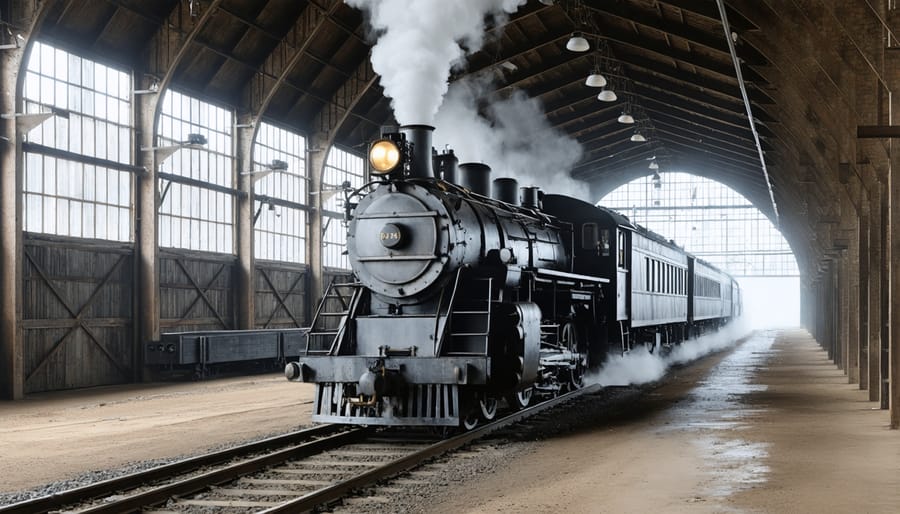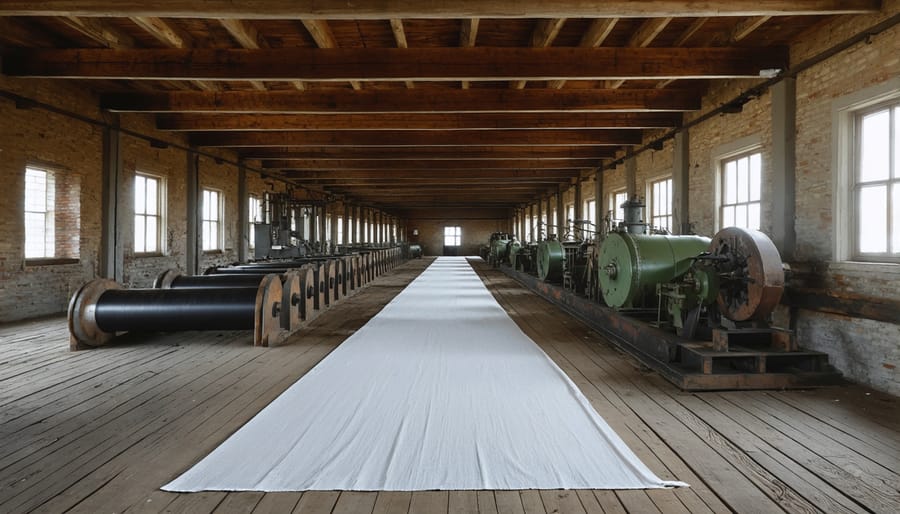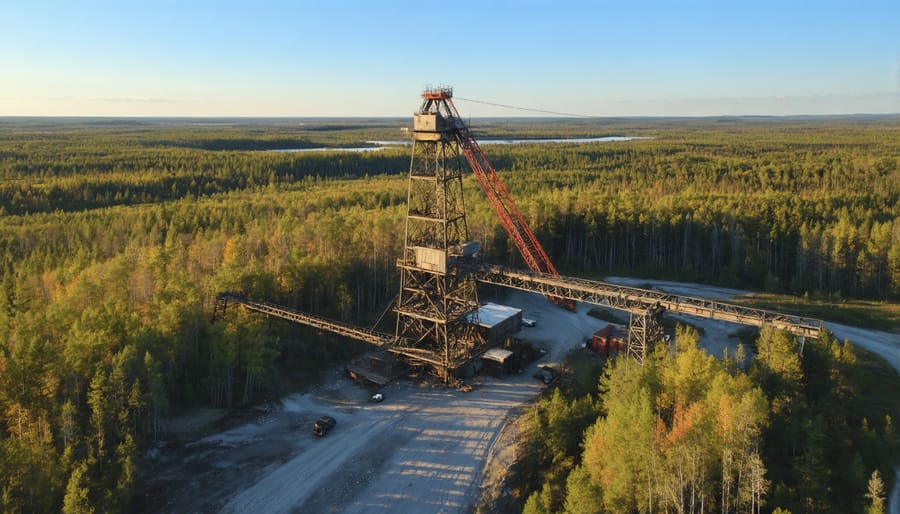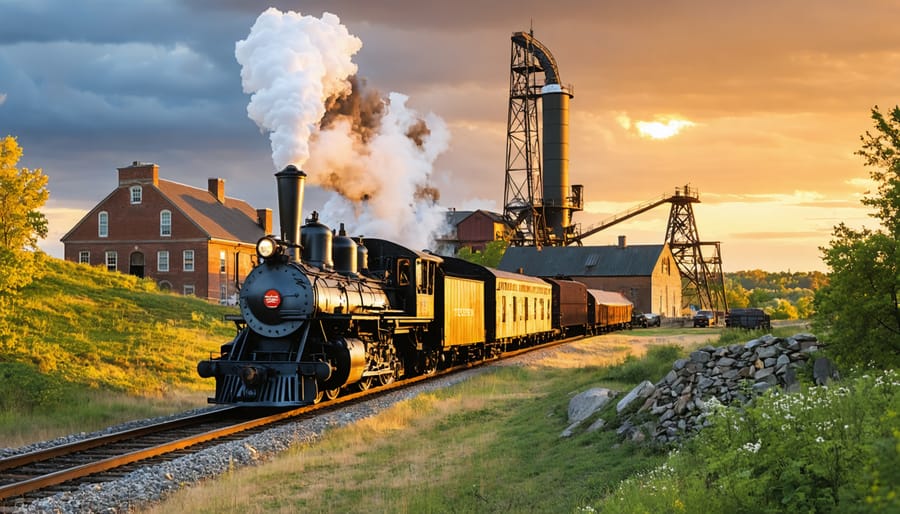Step into the transformative era of the Second Industrial Revolution, where steam-powered innovation gave way to electricity, mass production, and unprecedented technological advancement between 1870 and 1914. Ontario’s industrial landscape, shaped by the unwavering spirit of both immigrant workers and Indigenous communities, underwent a dramatic metamorphosis during this period. From the bustling factory floors of Toronto to the mighty steel mills of Hamilton, this revolutionary chapter forever changed how we live, work, and connect with one another.
Experience this remarkable transformation firsthand through Ontario’s preserved industrial heritage sites, where centuries-old brick facades and restored machinery tell stories of innovation, perseverance, and human ingenuity. Whether you’re exploring the historic Distillery District’s Victorian-era architecture or witnessing the massive scale of the Welland Canal, these living monuments offer an immersive journey into a period that laid the foundation for our modern world.
Pack your curiosity and comfortable walking shoes – Ontario’s industrial heritage awaits, ready to transport you back to an era that sparked the modern age we know today.
The Rise of Ontario’s Industrial Might (1850-1914)
Steam Power and Railway Heritage
Ontario’s railway heritage offers a fascinating glimpse into the era when steam power transformed our landscape. The South Simcoe Railway in Tottenham stands as one of the province’s most cherished attractions, where you can hop aboard a lovingly restored steam train for a journey through time. The rhythmic chug of the engine and the whistle echoing through the countryside create an unforgettable experience that connects you directly with our industrial past.
At the Hamilton Museum of Steam & Technology, housed in a stunning 1859 waterworks, you’ll find yourself surrounded by massive steam-powered pumping engines that once supplied the city with water. The original Pump House is a remarkable example of industrial architecture, and the sight of these giant machines in motion during special demonstration days is truly awe-inspiring.
The St. Jacobs & Aberfoyle Model Railway showcases miniature versions of Ontario’s steam era, with incredibly detailed recreations of 1950s railway stations and towns. It’s a perfect spot for families, where kids can marvel at the tiny trains while learning about our railway history.
Don’t miss the Roundhouse Park in Toronto, home to the Toronto Railway Museum. This preserved railway facility features a working turntable and several restored locomotives. Pro tip: Visit during one of their Steam Days events when you can see these magnificent machines in action and chat with passionate volunteers who bring the history to life.
For the eco-conscious explorer, many of these heritage sites now incorporate green initiatives, like LED lighting and recycling programs, while maintaining their historical authenticity.

Mining and Mineral Processing Legacy
Ontario’s rich mining heritage from the Second Industrial Revolution lives on through several remarkable sites that visitors can explore today. These historic locations, many situated on traditional territories, offer fascinating glimpses into the province’s industrial past.
The Cobalt Mining Museum and Heritage Silver Trail stands as a testament to Ontario’s silver mining boom. Walking through the preserved headframes and processing facilities, you can almost hear the echoes of miners’ picks from a century ago. Don’t miss the underground tunnel tour – it’s an unforgettable experience that puts you in the shoes of early industrial miners.
In Sudbury, the Dynamic Earth science center showcases the evolution of nickel mining. The Big Nickel, a giant replica of a 1951 Canadian nickel, has become an iconic symbol of the region’s mining heritage. Inside, interactive exhibits demonstrate how ore processing transformed from manual labor to automated systems during the industrial revolution.
For a hands-on experience, visit the Petrolia Discovery in Lambton County, where you can see restored oil equipment from the 1860s still in working order. The site’s volunteer guides share fascinating stories about the early days of Ontario’s petroleum industry.
Tip: Many of these sites offer guided tours led by former miners or their descendants, providing unique insights you won’t find in history books. Visit during shoulder season (spring or fall) for smaller crowds and more personal attention from guides. Remember to bring a camera – the industrial architecture makes for stunning photos, especially during golden hour.
Must-Visit Industrial Heritage Sites
Southern Ontario’s Manufacturing Giants
Step into Ontario’s industrial past as you explore the magnificent remnants of our manufacturing heritage. These preserved factories and mills stand as proud testaments to the province’s role in the Second Industrial Revolution, much like our historic fortifications tell stories of earlier times.
The Distillery District in Toronto offers one of the best-preserved Victorian industrial complexes in North America. Once home to the Gooderham and Worts Distillery, these beautifully restored red-brick buildings now house artisan shops, galleries, and restaurants while maintaining their original architectural charm.
In Hamilton, the Cotton Factory stands as a creative arts center today, but its walls echo with the memories of textile manufacturing that helped build the city. Pro tip: Visit during one of their open studio events to meet local artists who’ve given new life to this industrial space.
Cambridge’s old Galt Post Office and the nearby industrial buildings along the Grand River showcase the region’s manufacturing prowess. The limestone architecture and original machinery displays provide fantastic photo opportunities, especially during golden hour.
The Waterloo Region Museum, housed in a former textile mill, offers hands-on exhibits where you can experience what working life was like during the industrial boom. Here’s an insider secret: visit on weekday mornings to avoid crowds and get the most engaging experience with the interactive displays.
In St. Catharines, the old canal-side factories tell the story of how water power transformed manufacturing. For the best experience, take the self-guided walking tour along the old Welland Canal, where informative plaques help you imagine the bustling industrial corridor of the past.
Remember to bring your camera – these architectural giants provide stunning backdrops for photography enthusiasts. Most sites offer guided tours, and I’d recommend booking in advance, especially during summer months when tourism peaks.

Northern Ontario’s Resource Heritage
Northern Ontario’s landscape tells a fascinating story of our industrial heritage, where the raw power of nature met human ingenuity during the Second Industrial Revolution. The region’s vast forests and rich mineral deposits became the backbone of Ontario’s industrial growth, transforming quiet wilderness into bustling hubs of activity.
The mining heritage is particularly visible in Sudbury, where nickel extraction shaped not just the local economy but the entire region’s identity. Visitors today can explore the Dynamic Earth science center, which offers an immersive experience of mining history through interactive exhibits and an underground tour. Pro tip: Book your underground tour in advance during summer months, as they tend to fill up quickly.
The lumber industry’s legacy lives on in places like Blind River and Sturgeon Falls, where historic sawmills once processed thousands of logs floating down northern rivers. These water-powered mills were cutting-edge technology for their time, and some restored sites still demonstrate the impressive engineering of the era. For the best experience, visit during the annual logger’s festivals, where you can watch traditional logging demonstrations and try your hand at log rolling.
In places like Sault Ste. Marie, you’ll find the perfect blend of processing heritage and natural beauty. The Algoma Steel plant, established in 1901, stands as a testament to the region’s industrial might, while the nearby Canadian Bushplane Heritage Centre showcases how aviation supported these remote industrial operations.
For eco-conscious explorers, many sites now offer green tourism options. Consider joining guided hiking tours that combine industrial heritage with forest conservation education. Remember to pack a reusable water bottle and stick to marked trails to help preserve these historic sites for future generations.
These northern heritage sites aren’t just about the past – they’re living museums where you can experience firsthand how the Second Industrial Revolution shaped Ontario’s identity and continues to influence our present.

Planning Your Industrial Heritage Adventure
Best Times to Visit
The best time to explore Ontario’s industrial heritage sites is during the late spring to early fall (May through October), when the weather is most favorable for outdoor exploration. Many historic mills, factories, and colonial heritage sites offer extended summer hours and special programming during these months.
For photography enthusiasts, autumn provides stunning photo opportunities as the fall colors create a dramatic backdrop against historic brick buildings and iron structures. The cooler temperatures also make it more comfortable to explore outdoor industrial complexes and working demonstrations.
Several sites host special events throughout the year, including Victorian-era Christmas celebrations in December and Heritage Week activities in February. Summer weekends often feature live demonstrations of historic machinery and craft workshops, while spring brings unique industrial heritage festivals celebrating local manufacturing history.
Pro tip: Visit during weekday mornings to avoid crowds, especially at popular sites like the Distillery District. Many locations offer guided tours that are best booked in advance during peak season (July-August).
Visitor Tips and Safety Guidelines
When visiting industrial heritage sites, your safety and comfort are our top priorities. Always wear sturdy, closed-toe shoes as many sites have uneven surfaces and metal debris. Bring a water bottle and wear weather-appropriate clothing, as many locations are partially outdoors and can get quite warm or chilly depending on the season.
Remember to stay with your tour group and follow all posted signs and barriers. These historic sites often have restricted areas that aren’t safe for public access. Photography is usually allowed, but flash photography might be restricted in certain areas to protect delicate artifacts.
For the best experience, book your tours in advance, especially during peak summer months. Many sites offer guided tours that provide fascinating insights into the machinery and working conditions of the era. Consider visiting during shoulder seasons (spring or fall) when crowds are smaller and temperatures more comfortable.
Keep in mind that some industrial heritage sites have limited accessibility. If you have mobility concerns, contact the site beforehand to discuss accommodation options. And don’t forget to bring your curiosity – these sites tell fascinating stories of innovation and human ingenuity!
Today, these industrial heritage sites serve as powerful reminders of our past and invaluable educational resources for future generations. By preserving these locations, we not only honor the hard work and innovation of those who came before us but also gain a deeper understanding of how our modern world came to be. When you visit these historic industrial sites, you’re not just stepping into a museum – you’re experiencing living history that shaped Ontario’s development. Take time to appreciate the restored machinery, original architecture, and the stories of the workers who powered the Industrial Revolution. These sites also offer unique opportunities for photographers, history buffs, and families looking for meaningful educational experiences. By supporting these preservation efforts through our visits, we ensure that future generations can continue to learn from and be inspired by Ontario’s rich industrial heritage.














+ There are no comments
Add yours